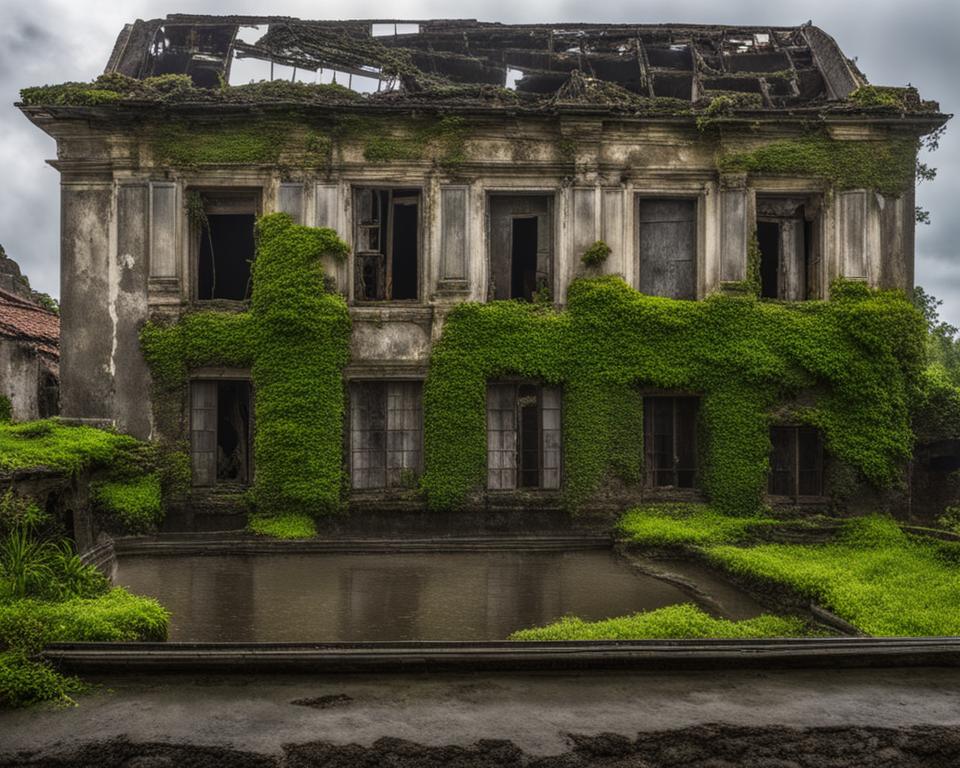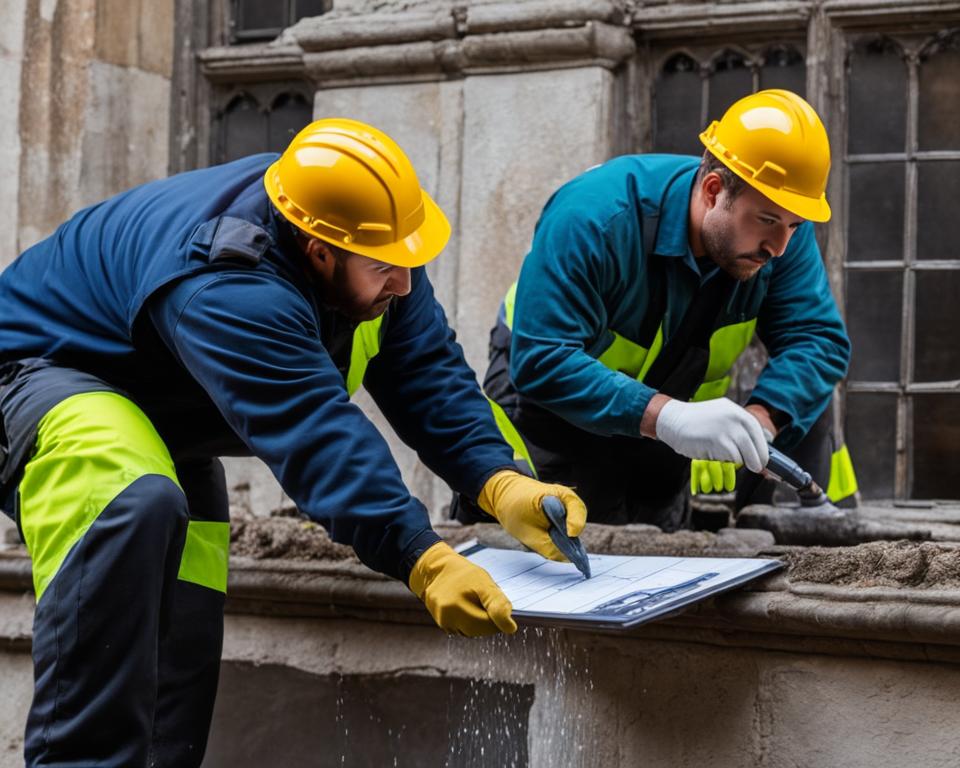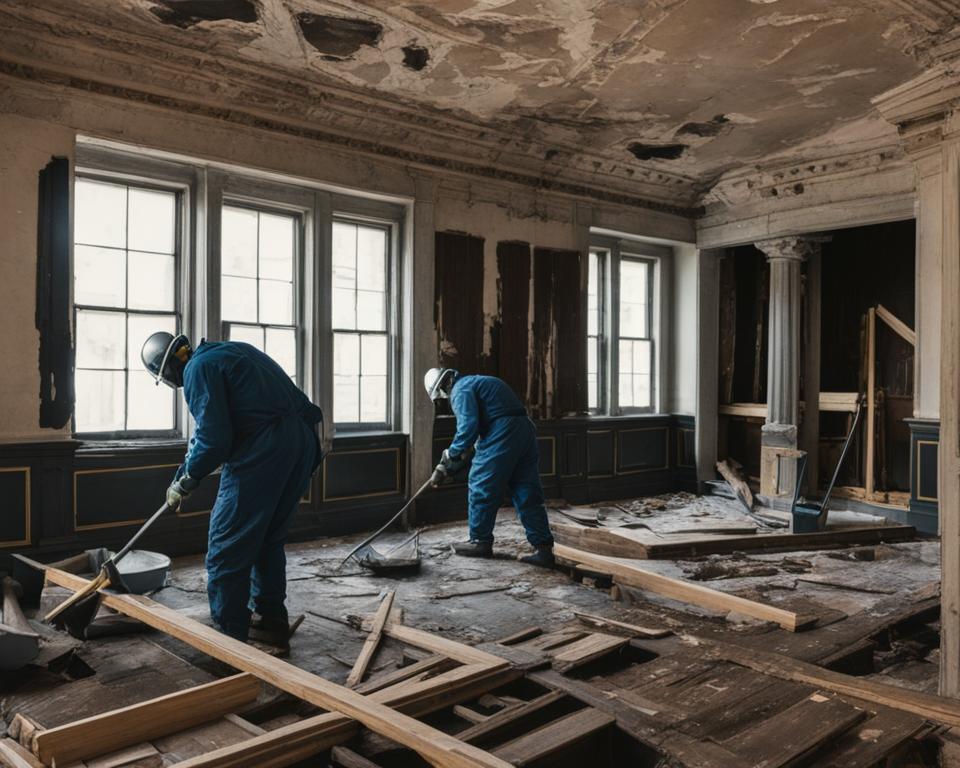When historical buildings are exposed to water damage, prompt action is crucial to prevent further deterioration and preserve their architectural and historical significance. Water damage restoration for historical buildings requires careful planning, assessment of the damage, and the implementation of appropriate restoration techniques.
One of the initial steps in restoring water-damaged historical buildings is to ensure the safety of the occupants and restoration professionals involved. Immediate measures should be taken to dry out the building and address any potential hazards. It is also essential to document the damage thoroughly for insurance purposes.
To prevent further water entry, temporary repairs should be made to roofs and windows, safeguarding the building from additional moisture intrusion. Addressing water saturation, ceiling and wall damage, handling sheetrock, cleaning and restoring features, removing wet carpets and furniture, restoring wood floors, and addressing issues in ductwork and basements are vital steps in the restoration process.
Controlled drying techniques play a significant role in maintaining the structural integrity of historical buildings and minimizing long-term damage.
Key Takeaways:
- Prompt action is essential to prevent further damage to water-damaged historical buildings.
- Temporary repairs should be made to roofs and windows to prevent further water entry.
- Controlled drying techniques are crucial to maintain the structural integrity of historical buildings.
- Thorough documentation of the damage is important for insurance purposes.
- Addressing water saturation, ceiling and wall damage, sheetrock handling, and restoration of features are key steps in the restoration process.
Strategies for Restoring Water-Damaged Historical Buildings
Restoring water-damaged historical buildings requires the implementation of careful restoration strategies to preserve their beauty and historical significance. The following techniques are essential for successful restoration:
- Prioritize safety precautions: Before proceeding with any restoration work, ensure that safety measures are in place to protect workers and occupants.
- Document the damage: Thoroughly document the extent of the water damage with photographs and written descriptions. This documentation will be crucial for insurance purposes and future reference.
- Prevent further water entry: After addressing the initial water intrusion, take steps to prevent any additional water from entering the building. Temporary repairs to roofs and windows should be made to create a watertight seal.
- Address water saturation: Identify and remove water-saturated materials such as carpets, insulation, and damaged drywall. These materials can harbor mold and compromise the structural integrity of the building.
- Inspect and repair ceilings and walls: Thoroughly check ceilings and walls for signs of water damage, including stains, cracks, and bulges. Repair and replace damaged sections as necessary.
- Handle sheetrock appropriately: Depending on the exposure to floodwater, sheetrock may need to be removed and replaced to prevent mold growth and structural issues.
- Clean and restore wood features: Wood elements such as beams, doors, and paneling require proper cleaning and restoration techniques to preserve their original beauty. Consult with experts to ensure the use of appropriate cleaning solutions and restoration methods.
- Remove wet carpets and furniture: Extract any remaining moisture from carpets and furniture, and ensure they are thoroughly dried before returning them to the restored building. If necessary, consult with professional restoration services for specialized cleaning and drying procedures.
- Restore wood floors properly: Wood floors in historical buildings may require specialized restoration techniques to ensure their longevity. Sanding, refinishing, and applying protective coatings are key steps in restoring water-damaged wood floors.
- Address water in ductwork and basements: Water infiltration can cause damage to ductwork and basements. Properly inspect, repair, and dry these areas to prevent further water damage and potential mold growth.
- Treat water-damaged household furnishings: Historical buildings often contain valuable furniture and furnishings that may be damaged by water. Consult with restoration experts to salvage and restore these items whenever possible.
By implementing these restoration strategies and following controlled drying methods, water-damaged historical buildings can be effectively restored and preserved for future generations to appreciate.
Mitigating Water Damage in Historical Structures
To ensure the preservation of historical structures, it is crucial to proactively mitigate water damage. By taking preventative measures, regular maintenance inspections, and implementing emergency response plans, historical properties can be better protected from water damage and potential deterioration.
Preventing Water Entry
Preventing water entry is key to safeguarding historical structures. To achieve this, measures such as inspecting and repairing roofs, gutters, and windows should be implemented regularly. Sealing any potential points of entry for water can go a long way in preventing serious water damage.
Maintenance Inspections
Regular maintenance inspections play a vital role in identifying potential issues that can lead to water damage. By conducting thorough inspections, property owners can detect early signs of leaks, cracks, or deteriorating materials, allowing for prompt repairs and prevention of further damage.
Building Occupancy and Maintenance
Keeping historical buildings occupied and well-maintained is an effective way to prevent damage caused by neglect. Regular occupancy ensures that any potential issues are promptly addressed, and maintenance tasks are carried out regularly, reducing the risk of water damage.
Storm Preparation and Emergency Response Plans
The implementation of a storm preparation plan is crucial for historical structures located in areas prone to severe weather events. This plan should outline steps to secure the building, minimize water entry, and protect valuable assets. Additionally, having an emergency response plan in place ensures a swift and efficient reaction to potential water damage during a storm.
In conclusion, historical structures can be better protected from water damage by taking proactive steps, conducting regular maintenance inspections, and implementing proper emergency response plans. By mitigating water damage, we can ensure the preservation of these irreplaceable pieces of history for generations to come.
Dealing with Various Causes of Building Damage
Building damage can occur due to various causes, including weather-related water damage, storms, structural issues, and criminal acts. Each of these factors can have significant consequences for the integrity and safety of buildings. Understanding the different causes of building damage is essential for effective mitigation and restoration efforts. Let’s explore each of these causes in detail.
1. Weather-related Water Building Damage
Weather events such as heavy rainfall, flooding, and hurricanes can result in water damage to buildings. Water intrusion can weaken the structural components of a building and lead to issues like mold growth, corrosion, and contamination. Prompt action is necessary to repair any water-related damage and prevent further deterioration.
2. Storm Building Damage
Storms, including severe winds, hail, and fire, can cause significant damage to buildings. Falling trees, debris, and flying objects can result in structural damage, broken windows, and roof leaks. Storm-related building damage requires immediate attention to ensure the safety of occupants and prevent further deterioration.
3. Structural Building Damage
Over time, lack of maintenance, exposure to natural elements, or poor construction practices can lead to structural issues in buildings. Cracks in walls, foundation problems, and compromised structural integrity pose serious risks. Regular maintenance inspections and timely repairs are crucial to prevent further damage and ensure the stability of the building.
4. Criminal Building Damage
Intentional acts of theft, vandalism, and trespassing can also cause damage to buildings. Broken windows, graffiti, stolen property, and other criminal activities can negatively impact the aesthetics, security, and functionality of a building. Implementing security measures and reporting any criminal acts can help minimize the risk and mitigate potential damage.

By understanding the different causes of building damage, property owners and stakeholders can take appropriate measures to mitigate risks and protect their investments. Regular maintenance inspections, prompt repairs, and security measures can go a long way in preventing or minimizing building damage.
Preventing and Minimizing Building Damage
To ensure the longevity and structural integrity of a building, it is crucial to implement preventative measures and minimize potential damage. By conducting routine building maintenance inspections, timely addressing structural issues, and keeping the building occupied, you can significantly reduce the risk of damage caused by neglect.
Regular inspections help identify any signs of structural issues or damage, allowing for prompt repairs and preventive measures. By addressing these issues early on, further deterioration can be prevented, saving both time and resources in the long run.
Keeping a building occupied plays a vital role in preventive maintenance. Occupants can help identify potential problems, such as leaks or structural weaknesses, and report them immediately. Moreover, regular occupation ensures that routine maintenance tasks, such as cleaning gutters and maintaining the HVAC system, do not fall by the wayside, minimizing the risk of damage due to neglect.
In areas prone to storms or severe weather events, creating and implementing a storm preparation plan is crucial to minimize potential damage. This plan should outline the necessary steps to secure the building and protect it from potential water intrusion, wind damage, or other weather-related risks. By having a well-defined plan in place, you can mitigate potential risks and protect the building and its occupants.
In addition to a storm preparation plan, having an emergency response plan is essential for effectively managing and minimizing damage in the event of an emergency situation. This plan should outline the necessary steps to be taken, including immediate actions, evacuation procedures, and communication protocols. By having a well-prepared emergency response plan, you can ensure a quick and efficient response, minimizing potential damage and ensuring the safety of occupants and assets.
By implementing routine building maintenance inspections, keeping the building occupied, creating a storm preparation plan, and having an emergency response plan in place, you can effectively prevent and minimize building damage. Taking a proactive approach to building maintenance and risk management is vital in safeguarding the building’s integrity and ensuring its long-term functionality.

Approaches to Repairing Historic Buildings
When it comes to repairing historic buildings, there are various approaches that can be taken to ensure their preservation and longevity. One of the main methods is historic building restoration, which involves carefully returning the building to its original appearance or a significant point in its history. This meticulous process also includes the removal of any evidence from other time periods, allowing the building’s unique historical character to shine through.
Another approach to repairing historic buildings is preservation. This technique focuses on maintaining and repairing the original historic materials of the building, aiming to retain its authenticity and integrity. By carefully preserving the historic elements, such as architectural features, façades, and interior details, the building’s historical significance is upheld for future generations to appreciate.
In cases where historic buildings have suffered extensive damage over the years, repair and reconstruction may be necessary. This approach involves studying the building’s original design and construction methods to reconstruct damaged sections while maintaining the overall historic character. By using traditional building techniques and materials, the repair process ensures that the building’s historical significance is restored.
Furthermore, adaptive reuse offers an innovative way to repair and revitalize historic buildings. This approach involves repurposing the building for modern functions while still maintaining its architectural and historical value. Adaptive reuse allows for the integration of new uses and technologies, breathing new life into these remarkable structures and ensuring their sustainability in the present and future.
FAQ
What are the important steps in restoring water-damaged historical buildings?
Important steps include drying out the building, assessing the damage, prioritizing safety precautions, documenting the damage, preventing further water entry, addressing water saturation, inspecting and repairing ceilings and walls, handling sheetrock, cleaning and restoring features, removing wet carpets and furniture, restoring wood floors, addressing water in ductwork and basements, and following controlled drying methods.
How can water damage in historical structures be mitigated?
Proactive measures such as regular maintenance inspections, creating storm preparation and emergency response plans, and keeping the building occupied can help prevent water damage in historical structures.
What are the common causes of building damage?
Building damage can occur due to weather-related water damage, storms, structural issues, and intentional acts of theft, vandalism, and trespassing.
How can building damage be prevented or minimized?
Building damage can be prevented or minimized through routine building maintenance inspections, keeping the building occupied, creating storm preparation and emergency response plans.
What are the different approaches to repairing historic buildings?
Different approaches include historic building restoration, preservation, repair and reconstruction, and adaptive reuse depending on the extent of damage, historic significance, proposed use, and code requirements.

Leave a Reply